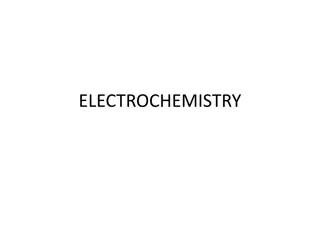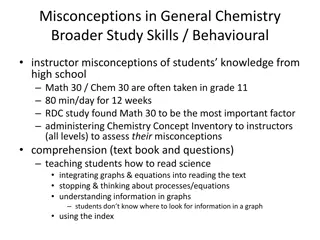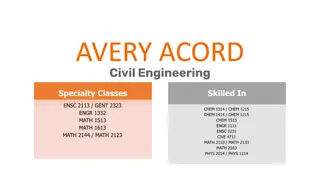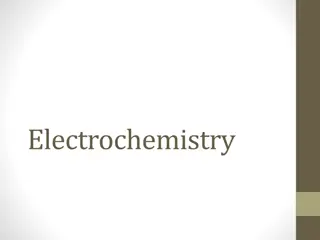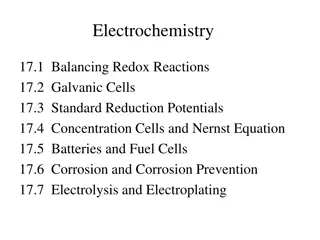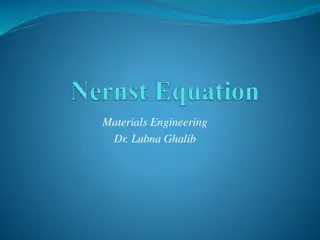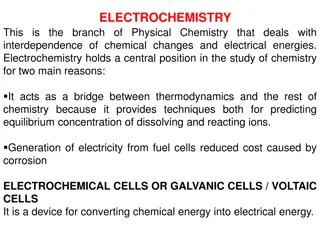Understanding Electrochemistry in Engineering Chemistry
Electrochemistry in engineering chemistry explores the interactions between electrical and chemical energy, involving the conversion of energy forms. It discusses electrical conductors, insulators, metallic conductors, good conductors, semiconductors, and electrolytic conductors. The concept of electrochemistry is crucial in understanding how electricity and chemical reactions intersect, highlighting the importance of conductance and resistance in different materials.
Download Presentation

Please find below an Image/Link to download the presentation.
The content on the website is provided AS IS for your information and personal use only. It may not be sold, licensed, or shared on other websites without obtaining consent from the author. Download presentation by click this link. If you encounter any issues during the download, it is possible that the publisher has removed the file from their server.
E N D
Presentation Transcript
ENGINEERING CHEMISTRY
CONCEPT OF ELECTROCHEMISTRY Electrochemistry is the study of chemical application. Electrochemistry deals with the interactions between electrical energy and chemical energy. These interactions are of two types i) Conversion of electrical energy into chemical energy ii) Conversion of chemical energy into electrical energy 3
Electrical Conductors: Substances which allows electric current through it. Ex: Metals, graphite,fused salts,aqueous solutions of acids, bases & salts. Types of conductors 1)electronic conductors 2)electrolytic conductors Non conductors or Insulators: Substances which does not allows electric current through it. Ex: Rubber, paper ,dry wood ,etc 4
METALLIC CONDUCTORS: Metallic conductors conduct electricity due to the movement of electrons from one end to another end. In a solid, the electrical conduction involves the free movement of electrons in the metallic lattice, without any movement of the lattice atom; this type of conduction is called metallic conduction. : In metallic conductors, the electricity is carried by the electrons, the atomic nuclei remaining stationary. These conductors are further sub classified in to three types. A. Good conductor B. Semi- conductor C. Non- conductor or Insulator
Good conductor: It is a substance, which conducts electricity fully and freely. EX: Metals like Copper, Aluminum, and Iron.
Semi- conductor: It is a substance, which partially conducts electricity. EX: Silicon, Germanium.
Electrolytic conductors Substances in their fused form or in aqueous form allow the passage of current undergoing a simultaneous chemical transformation are called electrolytes and the conduction as the electrolytic conductance Reciprocal of resistance is called as conductance C = 1/ R Units = mho Resistance (R) of a conductor is directly proportional to it s length (l)& inversely proportional to area of cross section (a) R l/a 8
Metallic conductors 1. Conductance is due to the flow of electrons. Electrolytic conductors: 1. Conductance is due to the movement of ions in a solution. 2. Chemical reactions take place at the electrodes. 3. Electrolytic conduction increases with increase in temperature. 4. It involves transfer of matter. 2. It does not result any chemical change. 3. Metallic conduction decreases with increase in temperature. 4. It does not involve any transfer of matter 9
Specific conductance: Specific conductance is the conductance of all the ions that are present in 1 ml solution. Units; ohm-1cm-1 . Equivalent conductance: Equivalent conductance is the conductance of total ions present in a solution containing 1 g equivalent of electrolyte. = Units:ohm-1cm2equiv-1 ^v = 10
Molar conductance: Molar conductance is the conductance of all the ions of 1 mole of electrolyte present in a solution. Units: = ohm-1cm2mole-1 11
EFFECT OF DILUTION: Generally conductance depends on three factors 1.number of ions 2.charge of ions 3.mobilityof ions As the dilution increases more, the electrolyte ionises more &specific conductance decreases. Equivalent &Molar conductance increases with dilution 12
ELECTROMOTIVE FORCE Electromotive Force is the difference of potential, which causes the current to flow from an electrode at higher potential to the one of lower potential. Ecell = E(right) - E(left) Ecell EMF of the cell. Eright reduction potential of right hand side electrode. Eleft reduction potential of left hand side electrode. 13
1.Potentiometric titrations can be carried out. 2. Transport number of ions can be determined. 3. PH can be measured. 4. Hydrolysis const. can be determined. 5. Solubility of sparingly soluble salts can be found. 14
GALVANIC CELL It is a cell in which chemical energy is converted to electrical energy. This cell consists of two half cells 1)Anodic half cell 2)Cathodic half cell At anodic half cell, oxidation takes place At cathodic half cell, reduction takes place 15
The following reactions take place in the cell. At Anode: Zn Zn+2 + 2e- (oxidation or de-elecronation) At cathode: Cu+2 + 2e- Cu ( Reduction or electronatioin) The movement of electrons from Zn to cu produces a current in the circuit. The overall cell reaction is: Zn +Cu+2 Zn+2 +Cu The galvanic cell can be represented by Zn/znso4//cuso4/cu 16
REFERENCE ELECTRODES An electrode of known potential is called reference electrode. Hydrogen electrode is the earliest primary reference electrode. The secondary reference electrodes discussed here are 1)Calomel electrode 2)Quinhydrone electrode 17
Primary & secondary reference electrodes : Standard hydrogen electrode(SHE):It is a primary reference electrode. The emf of such a cell is arbitrarily been fixed as zero. construction: It consists of a small platinum electrode coated with platinum black immersed in a 1M solution of H+ ions maintained at 250c. Hydrogen gas at one atmosphere pressure enters the glass hood and bubbles over the platinum electrode. The H2 gas at the platinum electrode passes into the solution forming H+ ions & electrons. H2 2H+ +2e- 18
By convention the standard electrode potential of hydrogen electrode when the hydrogen gas passed at one atmosphere pressure is bubbled through a solution of hydrogen ions of unit concentration is orbitarily fixed as zero. Nernst equation: At latm Ept,H2/H+ = E0pt,H2/H+-0.059 =E0pt, H2/H+ + 0.059 pH log aH+ 19
Depending on a half cell to which it is attached hydrogen electrode can act as a cathode or an anode. But in the given figure hydrogen electrode is connected to copper electrode & it act as anode ,when it is acting as anode ,oxidation takes place. 1/2H2(g)(1atm) H+ (1M)+e 20
Calomel electrode The calomel electrode consists of a glass tube having two side tubes. A small quantity of pure mercury is placed at the bottom of the vessel and is covered with a paste of Hg and Hg2 Cl2. KCl solution of known concentration is filled through side tube, Shown on the right side of the vessel. The KCl sol. is filled in the left side tube which helps to make a connection through a salt bridge with the other electrode, which potential has to be determined. A pt wire is sealed into a glass tube as shown in the fig which is in contact with Hg. When the cell is set up it is immersed in the given solution. 21
The electrode potentials of calomel electrode of different concentrations at 250c are 0.1 M KCl/ Hg2cl2 (s) / Hg,pt 0.33v 0.28v 1M KCl / H g2cl2 (s) / Hg,pt Saturated kcl /Hg2 cl2 (s) /Hg, pt 0.24v The corresponding electrode reaction is Hg2 Cl2 + 2e- 2Hg + 2cl- 22
Glass electrode Glass electrode is one of the type of ion selective electrode. (ISE). It is is made up of glass tube ended with small glass bulb sensitive to protons. Glass electrode The tube has strong and thick walls and the bulb is made as thin as possible. Inside of the electrode is usually filled with buffered solution of chlorides in which silver wire is covered with AgCl is immersed. The pH of internal solution can be varies. In this electrode, active part of electrode is the glass bulb. The surface of the glass is protonated by both internal and external solution till equilibrium is achieved. 23
Both sides of the glass are changed by the absorbed protons. And this charge is responsible for potential difference. This potential is directly proportional to the pH difference between the solutions on both sides of the glass. Glass electrode work in the pH range of 1-12 the glass electrode may be represented as Ag, AgCl/ Hcl (0.1N) / glass / H+ (unknown) Here Ag/AgCl acts as internal reference electrode. 24
17_369 Reference solution of dilute hydrochloric acid Silver wire coated with silver chloride Thin-walled membrane 25
Nernst studied the theoretical relationship between electrode reaction and the corresponding cell e.m.f. This relationship generally Known as Nernst equation. Consider a galvanic cell aA + bB cC + dD. Where a,b,c,d represents no. of moles respectively at equilibrium. The Nernst eq for the cell is written as - 26
- 2.303 In the above eq R= 8.314 J/K. T=298K, F=96, 500 columbs. By substituting the values in the eq - 0.0591 Applications: 1.It can be used to study the effect of electrolyte concentration on electrode potential. 2.the ph of the solution can be calculated from the measurement of emf and Nernst equation. 3.Nernst equation can also be used for finding the valency of an ions or the number of electrons involved in the electrode reaction 27
When the metals are arranged in the order of increasing reduction potentials or decreasing oxidation potentials which are determined with respect to one molar solutions of their ions and measured on the hydrogen scale, along series or list, resulted is called electrochemical or galvanic series. The higher a metal is in the series, the greater is its tendency to be oxidized. Applications 1. relative corrosion tendencies of the metals& alloys. 2.relative ease of oxidation or reduction of metals. 3.replacement tendency of metals. : 28
Batteries & Fuel Cells A history in pictures 30
1771-1800: The Galvani-Volta Controversy Luigi Galvani Animal Electricity Alessandro Volta 31
1800: The First Battery (Voltaic Pile) 1801: Volta presenting his battery to Napoleon 32
1821: The First Electric Motor 1835: The First BEV (Battery Electric Vehicle) Michael Faraday Sibrandus Stratingh 33
1839: First Fuel Cell (Groves Gas Battery) Sir William Grove 34
BATTERIES They are electrochemical cells connected in series Batteries are Store houses of electrical energy They are used as a source of direct electric current at constant voltage. They are classified into two types i) Primary cell ii) Secondary cell 36
Primary Batteries: These are non rechargeable & are meant for single use& discarded after use. Secondary Batteries: Voltaic cells whose electrochemical reactions can be reversed by a current of electrons running through the battery after the discharge of an electrical current. A secondary battery can be restored to nearly the same voltage after a power discharge. 37
Differences between Primary and secondary batteries: Primary cells 1. These are non-rechargeable and meant for a single use and to be discarded after use. 2. Cell reaction reversible. 3. Cannot be rechargeable. 4. Less expensive. 5. Can be used as long as the materials are active in their composition. Eg: Leclanche cell, Li Cells. Secondary cells 1. These are rechargeable and meant for multi cycle use. is not 2. Cell reaction can be reversed. 3. Can be rechargeable. 4. expensive. 5. Can be used again and again by recharging the cell. Eg; Lead- acid cell, Ni-cd cells. 38
PRIMARY CELL OR LECLANCHE CELL In this cell the reactions are irreversible It is also known as Dry cell Anode- Zinc container Cathode- Carbon rod Anode reaction Zn Zn2++2e- Cathode reaction 2NH4++2MnO2+2e- Mn2O3+2NH3+H2O Cell reaction 2MnO2+2NH4Cl+Zn Zn(NH3)2Cl2 + Mn2O3 +H2O 39
Lead Storage battery Anode reaction Pb+HSO4- PbSO4+H++2e- Cathode reaction PbO2+HSO4-+3H++2e- PbSO4+2H2O Cell reaction Pb+PbO2+ 2H++2HSO4- 2PbSO4+2H2O 40
Pb +PbO2 +H2SO4PbSO4(s)+H2O Lead Acid Recharging Low self-discharge 40% in one year (three months for Ni-Cd) No memory Cannot be stored when discharged Limited number of full discharges Danger of overheating during charging 41
Applications 1.Automobile and construction equipment. 2. Standby / backup system. 3. For engine batteries Advantages:- Low cost, long life cycle, Ability to withstand mistreatment, perform well in high and low temperature. 42
4. Lithium-ion battery (Li-ion Battery) Li-ion batteries are secondary batteries. The battery consists of a anode of Lithium, dissolved as ions, into a carbon. The cathode material is made up from Lithium liberating compounds, typically the three electro-active oxide materials, Lithium Cobalt-oxide (LiCoO2 ) Lithium Manganese-oxide (LiMn2 O4 ) Lithium Nickel-oxide (LiNiO2) 43
Principle During the charge and discharge processes, lithium ions are inserted or extracted from interstitial space between atomic layers within the active material of the battery. Simply, the Li-ion is transfers between anode and cathode through lithium Electrolyte. Since neither the anode nor the cathode materials essentially change, the operation is safer than that of a Lithium metal battery. The chemical reaction that takes place inside the battery is as follows, during charge and discharge operation: 44
Li- ion Electrolyte Li-Ion battery Principle 45
Advantages They have high energy density than other rechargeable batteries They are less weight They produce high voltage out about 4 V as compared with other batteries. They have improved safety, i.e. more resistance to over voltage. No liquid electrolyte means they are immune from leaking. . Fast charge and discharge rate Disadvantage They are expensive They are not available in standard cell types. 46
Applications The Li-ion batteries are used in cameras, calculators They are used in cardiac pacemakers and other implantable device They are used in telecommunication equipment, instruments, portable radios and TVs, pagers They are used to operate laptop computers and mobile phones and aerospace application 47
FUEL CELLS The cell that converts energy of combustion of fuels like Hydrogen, Methane to electrical energy. Fuels are usually gas or liquid, with oxygen as the oxidant.. Different fuel cells are The direct conversion of chemical energy to electrical energy has 100%. The cell representation is as follows. Fuel/electrode//electrolyte//electrode//oxidant Types of Fuels: 1.Hydrogen Oxygen Fuel cell 2.Methanol Oxygen fuel cell 49
LIMITATIONS OF FUEL CELLS Large weight and volume of hydrogen gas fuel storage system High cost of Hydrogen gas, technological advances should bring the cost down Lack of infrastructure for distribution and marketing of Hydrogen gas. Most basic fuel cells suffer from carbon di oxide leakages and should be prevented from entering the cell and reacting with the electrolyte. 50







